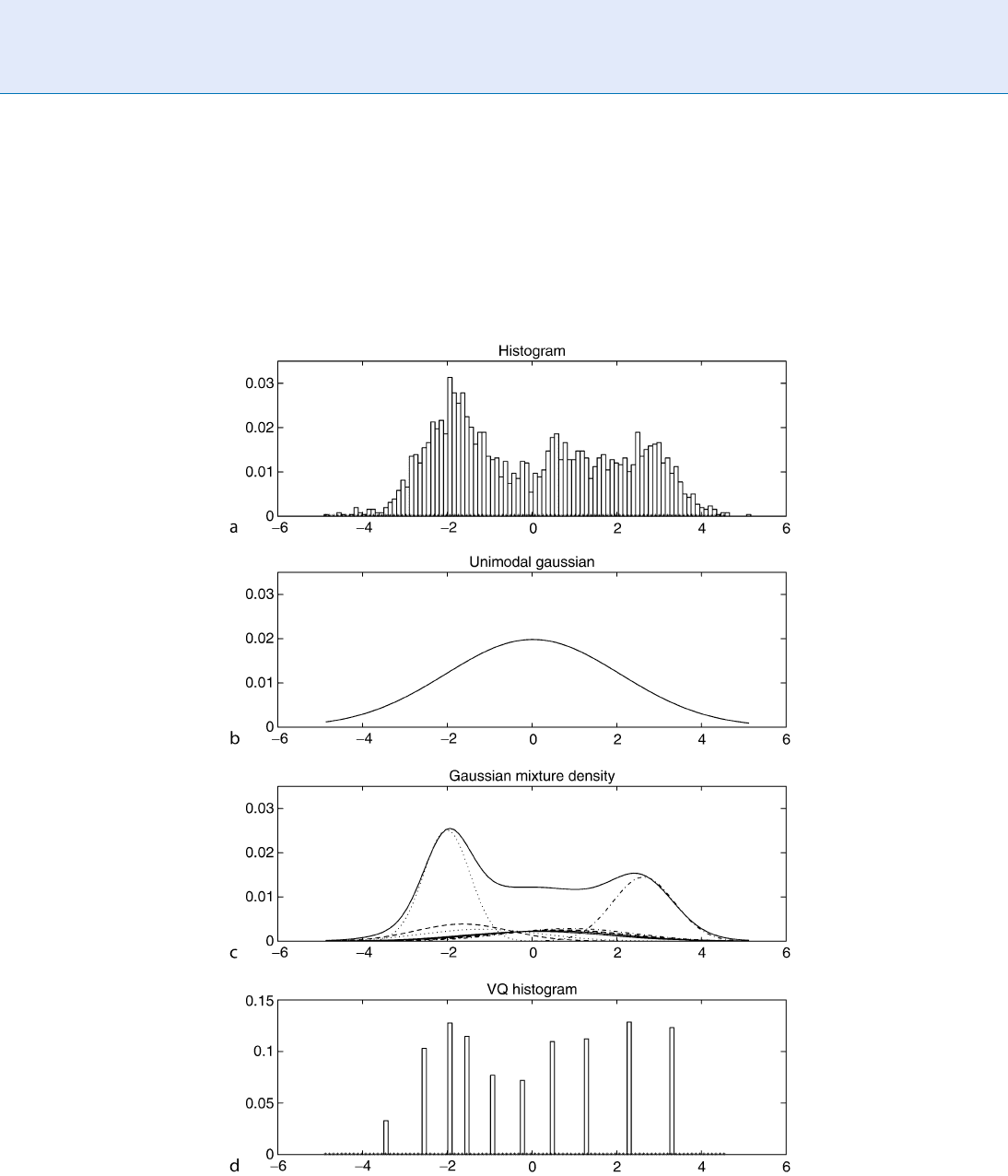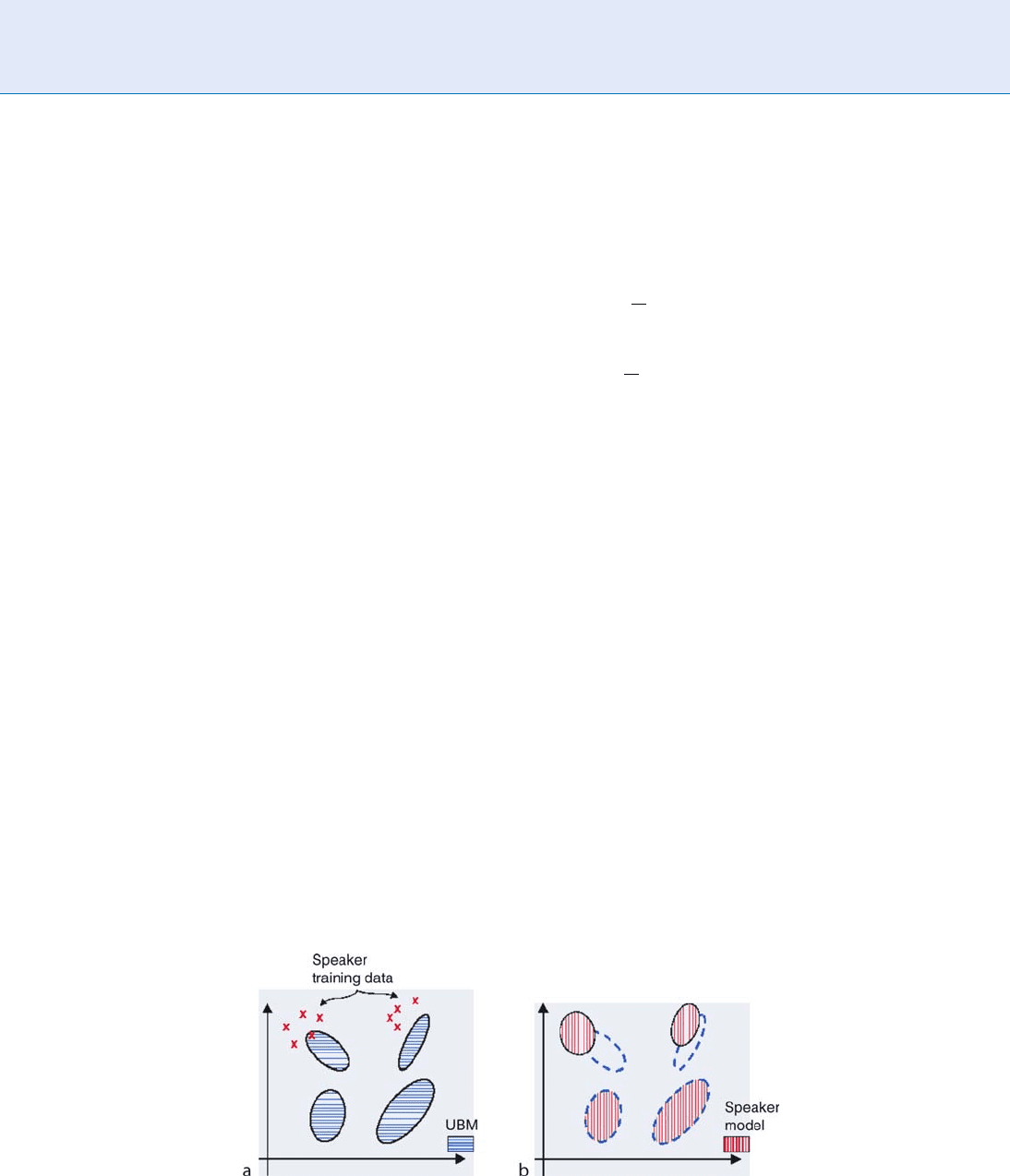Li S.Z., Jain A.K. (eds.) Encyclopedia of Biometrics
Подождите немного. Документ загружается.


of characteristic templates [3]. A GMM acts as a hybrid
between these two models by using a discrete set of
Gaussian functions, each with its own mean and
covariance matrix, to allow a better modeling
capability. Figure 1 compares the densities obtained
using a unimodal Gaussian model, a GMM, and a
VQ model. Plot (a) shows the histogram of a single
feature from a speaker recognition system (a single
cepstral value from a 25 second utterance by a male
speaker); plot (b) shows a unimodal Gaussian model of
this feature distribution; plot (c) shows a GMM and
its ten underlying component densities; and plot
(d) shows a histogram of the data assigned to the
VQ centroid locations of a ten element codebook.
Gaussian Mixture Models. Figure 1 Comparison of distribution modeling. (a) histogram of a single cepstral
coefficient from a 25 second utterance by a male speaker (b) maximum likelihood unimodal Gaussian model (c) GMM
and its ten underlying component densities (d) histogram of the data assigned to the VQ centroid locations of a
ten element codebook.
660
G
Gaussian Mixture Models

The GMM not only provides a smooth overall distri-
bution fit, its components also clearly detail the multi-
modal nature of the density.
The use of a GMM for representing feature distri-
butions in a biometric system may also be motivated
by the intuiti ve notion that the individual component
densities may model some underlying set of hidden
classes. For example, in speaker recognition, it is reason-
able to assume the acoustic space of spectral related
features corresponding to a speaker’s broad phonetic
events, such as vowels, nasals, or fricatives. These acous-
tic classes reflect some general speaker-dependent vocal
tract configurations that are useful for characterizing
speaker identity. The spectral shape of the ith acoustic
class can in turn be represented by the mean m
i
of
the ith component density, and variations of the aver-
age spectral shape can be represented by the covari-
ance matrix S
i
. Since all the features used to train the
GMM are unlabeled, the acoustic classes are hidden in
that the class of an observation is unknown. A GMM
can also be v iewed as a single-state HMM with a
Gaussian mixture observation density , or an ergodic
Gaussian observation HMM with fixed, equal transition
probabilities. Assuming independent feature vectors, the
observation density of feature vectors drawn from these
hidden acoustic classes is a Gaussian mixture [4, 5].
Maximum Likelihood Parameter
Estimation
Given training vectors and a GMM configuration, the
parameters, l, are estimated which, in some sense, best
match the distribution of the training feature vectors.
There are several techniques available for estimating
the parameters of a GMM [6]. By far the most popular
and well-established method is
▶ maximum likelihood
(ML) estimation.
The aim of ML estimation is to find the model
parameters which maximize the likelihood of the
GMM given the training data. For a sequence of T
training vectors X ¼fx
1
; ...; x
T
g, the GMM likeli-
hood, assuming independence between the vectors
(The independence assumption is often incorrect but
is needed to make the problem tractable.), can be
written as,
pðXjlÞ¼
Y
T
t¼1
pðx
t
jlÞ: ð4Þ
Unfor tunately, this expression is a nonlinear function
of the param eters l and direct maximization is not
possible. However, ML paramet er estimates can be
obtained iteratively using a special case of the expecta-
tion-maximization (EM) algorithm [7].
The basic idea of the EM algorithm is, beginning
with an initial model l, to estimate a new model
l,
such that pðXj
lÞpðXjlÞ. The new model then
becomes the initial model for the next iteration and
the process is repeated until some convergence thresh-
old is reached. The initial model is typically derived by
using some form of binary VQ estimation.
On each EM iteration, the following re-estimation
formulas are used which guarantee a monotonic
increase in the model’s likelihood value,
Mixture Weights
w
i
¼
1
T
X
T
t¼1
Prðijx
t
; lÞ: ð5Þ
Means
m
i
¼
P
T
t¼1
Prðijx
t
; lÞ x
t
P
T
t¼1
Prðijx
t
; lÞ
: ð6Þ
Variances (diagonal covariance)
s
2
i
¼
P
T
t¼1
Prðijx
t
; lÞ x
2
t
P
T
t¼1
Prðijx
t
; lÞ
m
2
i
; ð7Þ
where s
i
2
, x
t
, and m
i
refer to arbitrary elements of the
vectors s
i
2
, x
t
, and m
i
, respectively.
The a posteriori probability for component i is
given by
Prðijx
t
; lÞ¼
w
i
gðx
t
jm
i
; S
i
Þ
P
M
k¼1
w
k
gðx
t
jm
k
; S
k
Þ
ð8Þ
Maximum A Posteriori (MAP) Parameter
Estimation
In addition to estimating GMM parameters via the
EM algorithm, the parameters may also be estimated
using Maximum A Posteriori (MAP) estimation. MAP
Gaussian Mixture Models
G
661
G

estimation is used, for example, in speaker recognition
applications to derive speaker mod el by adapting
from a universal background model (UBM) [8]. It is
also used in other pattern recognition tasks where limited
labeled training data is used to adapt a prior , general
model.
Like the EM algorithm, the MAP estimation is a
two-step estimation process. The first step is identical
to the ‘‘Expectation’’ step of the EM algorithm, where
estimates of the sufficient statistics (These are the basic
statistics needed to be estimated to compute the de-
sired parameters. For a GMM mixture, these are the
count, and the first and second moments required to
compute the mixture weight, mean and variance.) of
the training data are computed for each mixture in
the prior model. Unlike the second step of the EM
algorithm, for adaptation these ‘‘new’’ sufficient statis-
tic estimates are then combined with the ‘‘old’’ suffi-
cient statistics from the prior mixture parameters
using a data-dependent mixing coefficient. The data-
dependent mixing coefficient is designed such that
mixtures with high counts of new data rely more on
the new sufficient statistics for final parameter estima-
tion and mixtures with low counts of new data rely
more on the old sufficient statistics for final parameter
estimation.
The specifics of the adaptation are as follows. Given
a prior model and training vectors from the desired
class, X ¼fx
1
...; x
T
g, the probabilistic alignment
of the training vectors into the prior mixture compo-
nents is determined (Fig. 2a). That is, for mixture i
in the prior model, Prðijx
t
; l
prior
Þ is computed as
in Eq. (8).
Then compute the sufficient statistics for the
weight, mean, and variance parameters x
2
is shorthand
for diag(xx
0
):
n
i
¼
X
T
t¼1
Prðijx
t
; l
prior
Þ weight; ð9Þ
E
i
ðxÞ¼
1
n
i
X
T
t¼1
Prðijx
t
; l
prior
Þx
t
mean; ð10Þ
E
i
ðx
2
Þ¼
1
n
i
X
T
t¼1
Prðijx
t
; l
prior
Þx
2
t
variance: ð11Þ
This is the same as the ‘‘Expectation’’ step in the EM
algorithm.
Lastly, these new sufficient statistics from the
training data are used to update the prior sufficient
statistics for mixture i to create the adapted parameters
for mixture i (Fig . 2b ) with the equations:
^
w
i
¼ a
w
i
n
i
=T þð1 a
w
i
Þw
i
g
adapted mixture weight;
ð12Þ
^
m
i
¼ a
m
i
E
i
ðxÞþð1 a
m
i
Þm
i
adapted mixture mean;
ð13Þ
^
s
2
i
¼ a
v
i
E
i
ðx
2
Þþð1 a
v
i
Þðs
2
i
þ m
2
i
Þ
^
m
2
i
adapted mixture variance
ð14Þ
The adaptation coefficients controlling the balance
between old and new estimates are {a
i
w
, a
i
m
, a
i
v
} for
the weights, means, and variances, respectively. The
scale factor, g, is computed over all adapted mixture
weights to ensure that they sum to unity. Note that the
Gaussian Mixture Models. Figure 2 Pictorial example of two steps in adapting a hypothesized speaker model.
(a) The training vectors (x’s) are probabilistically mapped into the UBM (prior) mixtures. (b) The adapted mixture
parameters are derived using the statistics of the new data and the UBM (prior) mixture parameters. The adaptation
is data-dependent, so UBM (prior) mixture parameters are adapted by different amounts.
662
G
Gaussian Mixture Models

sufficient statistics, not the derived parameters, such as
the variance, are being adapted.
For each mixture and each parameter, a data-
dependent adaptation coefficient a
i
r
, r 2 {w, m, v},
is used in the equations mentioned earlie r. This is
defined as
a
r
i
¼
n
i
n
i
þ r
r
; ð15Þ
where r
r
is a fixed ‘‘relevance’’ factor for parameter r.
It is common in speaker recognition applications
to use one adaptation coefficient for all parameters
(a
i
w
¼ a
i
m
¼ a
i
v
¼ n
i
∕(n
i
þ r)) and further to only
adapt certain GMM parameters, such as only the mean
vectors.
Using a data-dependent adaptation coefficient
allows mixture-dependent adaptation of paramet ers.
If a mixture component has a low probabilistic count,
n
i
, of new data, then a
i
r
! 0 causing the de-emphasis
of the new (potentially under-trained) parameters and
the emphasis of the old (better trained) parameters.
For mixture components with high probabilistic
counts, a
i
r
! 1, causing the use of the new class-
dependent parameters. The relevance factor is a way
of controlling how much new data should be observed
in a mixture before the new parameters begin replacing
the old parameters. This approach should thus be
robust to limited training data.
Related Entries
▶ Session Effects on Speaker Modeling
▶ Speaker Matching
▶ Speaker Recognition, Overview
▶ Universal Background Models
Acknowledgment
This work was sponsored by the Department of
Defense under Air Force Contract FA8721-05-C-0002.
Opinions, interpretations, conclusions, and recom-
mendations are those of the authors and are not neces-
sarily endorsed by the United States Government.
References
1. Benesty, J., Sondhi, M., Huang, Y. (eds.): Springer Handbook of
Speech Processing, vol. XXXVI. Springer, Berlin (2008)
2. Mu
¨
ler, C. (ed.): Speaker Classification I: Fundamentals, Features,
and Methods, vol. 4343/2007. Springer: Lecture Notes in Com-
puter Science, Berlin (2007)
3. Gray, R.: Vector qantization. In: IEEE ASSP Magazine, pp. 4–29
(1984)
4. Reynolds, D.A.: A Gaussian Mixture Modeling Approach to
Text-Independent Speaker Identification. PhD thesis, Georgia
Institute of Technology (1992)
5. Reynolds, D.A., Rose, R.C.: Robust text-independent
speaker identification using Gaussian mixture speaker
models. IEEE Trans. Acoust. Speech Signal Process. 3(1), 72–83
(1995)
6. McLachlan, G. (ed.): Mixture Models. Marcel Dekker, New York,
NY (1988)
7. Dempster, A., Laird, N., Rubin, D.: Maximum likelihood from
incomplete data via the EM algorithm. J. Royal Stat. Soc. 39(1),
1–38 (1977)
8. Reynolds, D.A., Quatieri, T.F., Dunn, R.B.: Speaker verification
using adapted Gaussian mixture models. Digital Signal Process.
10(1), 19–41 (2000)
GC
GC is an analytical chemistry separation technique
which provides separation of mixtures on the basis of
differential affinity between a liquid or solid stationary
phase and a gas mobile phase.
▶ Odor Biometrics
Gelatin Pad
Gelatin lifting pads are designed for the lifting of
fingerprints, footprints, dust marks , and trace evi-
dences. They comprise three layers, the first layer is
the carri er, which holds the second layer of thick low-
adhesive gelatin in a pliable and flexible format. The
thick gelatin layer is ideal for lifting evidence without
sticking to the surrounding lift area. The third layer, a
cover sheet, is a clear polyester film which is removed
prior to lifting, and may be replaced once the lift is
completed.
▶ Footwear Recognition
Gelatin Pad
G
663
G

General Model
▶ Universal Background Models
Generalization
The classifier is designed to correctly classify unseen
objects which are not used during the training process.
Generalization represents the capacity of the class ifier
to respond to this task. When a classifier has a good
generalization capacity, it can correctly classify unseen
examples.
▶ Ensemble Learning
▶ Support Vector Machine
Generalization Error
The generalization error of a machine learning model
is a function that measures how far the student ma-
chine is from the teacher machine in average over the
entire set of possible data that can be generated by the
teacher after each iteration of the learning process. It
has this name because this function indicates the ca-
pacity of a machine that learns with the specified
algorithm to infer a rule (or generalize) that is used
by the teacher machine to generate data based only on
a few examples.
▶ Image Pattern Recognition
Generative Classifier
A generative classifier is a classification algorithm that
learns the full joint distribution of class and attribute
values. As a result, it can generate labeled instances
according to this distribution. To classify an unlabeled
instance, one commonly uses the Bayes decision
theor y.
▶ Fusion, Quality-Based
Genetic Identification
Identification of a victim based on the victim’s DNA
samples.
▶ Dental Biometrics
Genuine Matching
Genuine matching is matching of two templates gen-
erated from the same finge r.
▶ Fingerprint Matching, Automatic
▶ Individuality of Fingerprints
Genuine Sign
Genuine sign, also called genuine signature, is a legal
sign. It is legally accepted as the registered sign.
▶ Signature Matching
Genuine/Impostor Attempt
In a genuine attempt, a biometric sample is compared
against other biometric samples from the same subject.
If similarity between the samples is not high enough,
the subject will be wrongly rejected by the system .
In an impostor attempt, a biometric sample is com-
pared against biometric samples from other subjects.
664
G
General Model

If similarity between the samples is high enough, the
subject will be wrongly accepted by the system. It
should be noted that biometric samples from the
same user are not necessarily similar (e.g., temporary
injuries in the finger) and on the other hand, biometric
samples from different users can be quite similar (e.g.,
signature forgeries).
▶ Fingerprint Databases and Evaluation
Geodesic
Geodesic is the integral curve between two points
corresponding to the gradient direction of the intrinsic
distance function of the manifold.
▶ Manifold Learning
Geometry Image
A geometry image is the result of representing all
vertices of a 3D object (x, y, and z coordinates) as a
simple 2D array of quantized points. Geometry images
have at least three channels assigned to each u, v pair of
coordinates, encoding geometric information (x, y, z
coordinates) of a vertex in R
3
, but surface normals and
colors can also be stored using the same implicit sur-
face parametrization. Creating a geometry image is
accomplished by cutting an arbitrary mesh along a
network of edge paths and parametrizing the resulting
single chart onto a square.
▶ Face Recognition, 3D-Based
Global Fusion
Global fusion in the framework or multi-biometric
score fusion refers to user-independent score fusion
techniques in which a uni que fusion function is used
for all users, which is trained based on background
data from a pool of users (both genuine and impostor
scores).
▶ Fusion, User-Specific
Global Thresholding Techniques
Global thresholding technique is used to convert an
image consisting of gray scale pixels to one containing
only black and white pixels. Usually a pixel value of
0 represents white and the value 255 represents black
with the numbers from 1 to 254 representing different
grey levels. A threshold value Th is chosen in the range
of 1–254 and each grey pixel P in the image is modified
to either black or white according to the test.
If P Th then P = 255 (white) orelse P = 0 (black).
There are a number of ways to select the value of
threshold Th depending on the nature of grey pixel
distributions in the image.
▶ Hand Vein
Glottal Excitation
The glottal excitation corresponds to the pulsating
flow of air that comes from the lungs through the
vibrating vocal folds. This first process of the human
speech production mechanism is named after the ori-
fice between the vocal folds, the glotti s.
▶ Speech Production
Glyph
A glyph is the shape of a handwriting sam ple. In
Roman scripts, it may contain one letter or even a
Glyph
G
665
G

group of letters depending on the content of the sam-
ple. In orienta l scripts, a glyph corresponds to a char-
acter which consists of a set of strokes.
▶ Signature Sample Synthesis
GMM
▶ Gaussian Mixture Models
Graph Matching
The configural identification of a face relating to the
measurable distances between features and the relative
ratios of height and width. A unique algorithm is
created from the key points on the face; this algorithm
is regarded as a unique biometric identifier.
▶ Face, Forensic Evidence of
Graphic Tablet
▶ Digitizing Tablet
Graphical User Interface
▶ User Interface, System Design
Graphometric Features
Graphometric features are intrinsic properties from an
individual handwriting style, which may be employed
by forensic experts during handwriting or signature
recognition. These include curvature and pressure
among others.
▶ Signature Features
Gray Scale
A continuous-tone image that has one component,
which is luminescent.
▶ Vascular Image Data Format, Standardization
GRF (Ground Reaction Force)
The ground reaction force is, according to Newton’s
law of reaction, the force equal in magnitude but
opposite in direction produced from the ground as
the reaction to force the body exerts on the ground.
The ground reaction force is used as propulsion to
initiate and control the movement, and is normally
measured by force sensor plates.
▶ Footstep Recognition
Ground-Truth
The actual facts of a situation, without errors intro-
duced by sensors, software processing or human per-
ception and judgment. For example the actual location
of a minutia in a fingerprint image that could be used
to check the accuracy of the location reported by a
given automated minutiae extraction algorithm.
▶ SFinGe
Gummy Bear Finger
▶ Fingerprint Fake Detection
666
G
GMM

H
Haar-Like Features
Similar to the what Haar wavelets are developed for
basis functions to encode signals, the objective of two-
dimensional Haar features is to collect local oriented
intensity difference at different scale for representing
image patters. This representation transforms an image
from pixel space to the space of wavelet coefficients
with an over-complete dictionary of features. Such
features can be used to represent face and pedestrians
images. The Haar-like features, similar to Haar wave-
lets, compute local oriented intensity difference using
rectangular blocks (rather than pixels) which can be
computed efficiently with an integral image.
▶ Face Detection
Habituated Subject
A user of a biometric system who is well versed in its
use; someone who routinely uses a biometric system.
▶ Iris on the Move
Habituation
The academic and medical world has several different
definitions for habituation. Two recurrent characteris-
tics in the literature are acclimation and habituation.
The first is acclimation, which consists of a user’s first
exposure to a device or process, the formal training
that goes along with it, and individual learning and
experimentation. The second characteristic, habitua-
tion consists of two parts, partially habituated and fully
habituated.
1. Acclimation is the process in which a user of a
biometric system adapts his or her techniques to
achieve a proper match of his or her biometric
template.
2. External Teaching is the formal tr aining that a
user receives revealing proper techniques and the
series of steps included with using the biometric
system.
3. Self teaching occurs after external teaching where a
user experiments with the device and begins to
eliminate techniques that do not work well or are
not comfortable. Through this iterative process,
techniques that work are narrowed, leading to par-
tial habituation.
4. Partial habituation is defined as the period of time
when no new adaptation of techniques is used to
achieve a proper match to the biometric template.
5. Full or complete habituation is defined as the point
at which a user match es his or her biometric tem-
plate using subconscious techniques.
▶ Ergonomic Design for Biometric Systems
Halo Effect
The temperatu re difference between a wet finger and
the platen of an optical sensor generates a halo on the
final image around the fing erprint.
▶ Fingerprint, Palmprint, Handprint and Soleprint
Sensor
#
2009 Springer Science+Business Media, LLC

Hamming Distance
A measurement of the (dis)similarity between two
strings of bits having equal leng th, based on tallying
how many corresponding pairs of bits in the two
strings disagree. If each string has N bits, then a cardi-
nal Hamming Distance is the count of disagreeing bits
and is thus an integer between 0 and N inclusively.
Alternatively, a fractional Hamming Distance nor-
malizes (divides) this count by the total N and is thus
a rational number between 0 and 1. Hamming Dis-
tance is an extremely fast metric to compute because it
can be implemented digitally by simple Exclusive-OR
logic operating in parallel on chunks of bits as large as
thewordlengthoftheprocessoritself(e.g.,64bitsat
once) in a single ex ecutable instruction cycle, and thus
within almost a single ‘‘tick’’ of the system clock. In
dedicated hardwar e there is no necessary limit to how
many bits can be X OR’ed at once, thus allowing Hamming
Distances to be computed at virtually unlimited rates.
This confers an advantage to this similarity metric when
searching databases on a national scale. A normalized
Hamming Distance is the metric underlying the matching
of IrisCodes for recognizing persons by their iris patterns.
▶ Iris Encoding and Recognition using Gabor Wavelets
▶ Score Normalization Rules in Iris Recognition
Hand Biometrics
▶ Hand Geometry
Hand Biometrics, 3D
▶ Finger Geometry, 3D
Hand Contour
▶ Hand Shape
Hand Data Interchange Format,
Standardization
RAUL SANCHEZ-REILLO
1
,SAMIR TAMER
2
1
University Carlos III of Madrid, Avda. Universidad,
Leganes (Madrid), Spain
2
Ingersoll Rand Recognition Systems, Dell Avenue,
Campbell, CA, USA
Synonyms
Encoding of hand geometry information; Hand
silhouette data
Definition
Standard that defines a common format to code infor-
mation related to hand geometry based biometrics. This
format is defined to allow interoperability among dif-
ferent vendors worldwide, and has been developed by
the international community taking part in ISO/IEC
JTC1/SC37 standardization subcommittee.
Introduction
Subcommittee SC37 from ISO/IEC JTC1 deals with
the standardization of biometrics. Among SC37 Work-
ing Group 3 is devoted to define Interchange Data
Formats for biometric modalities, among other duties.
For that purpose, a multipart standard is und er devel-
opment, and it is referred to by the number ISO/IEC
19794. Part 10 of the multipart standard covers hand
geometry biometrics, and is denoted ISO/IEC 19794-
10. The full title is ‘‘Information technology - Biometric
data interchange formats - Part 10: Hand geometry
silhouette data’’[1].
This International Standard provides a data inter-
change format, based on a CBEFF data block [2], for
applications requiring an interoperable hand geometry
record. The information consists of a variety of manda-
tory and optional items, including data capture para-
meters, standardized hand position, and vendor specific
information. This information is intended for inter-
change among organizations that rely on automated
devicesandsystemsforidentificationorverification
purposes based on the information from hand geometry.
668
H
Hamming Distance

It is important to note that although this part of
ISO/IEC 19794 mandates a particular data format, it
does not mandate a par ticular algorithm. For example,
a user may be enrolled on a system from one vendor,
and verified on a system from another.
Also, an important issue is that this format stores
hand silhouette data rather than color or greyscale
image data. To increase the flexibility of the data for-
mat, provisions have been made to store views of the
left and right hands, in addition to multiple views of
each hand.
Specific implementations of this part of ISO/IEC
19794 that could be constrained by storage space or
transmission capability (such as smart card applica-
tions) may wish to limit the num ber of views stored for
each hand. Such limitations are outside the scope of
this part of ISO/IE C 19794, but authors of the Interna-
tional Standard advise that the reduced choices can
prejudice interoperability.
Silhouette Acquisition Requirements
The capture device as well as the capture process is out
of the scope of the standard. As already mentioned,
this is not an image-based standard, but one related to
the coding of the shape of the hand. Therefore, no
matter what camera has been used for acquiring the
sample (black and white, colour, resolutions, etc.), or
which algorithm has been used for preprocessing such
image, the prim ary input for this document is such
preprocessed image, showing the silhouette of the
hand captured. This silhouette can be either the one
referring to the top-view of the hand, or its side-view.
Figure 1 shows the standardized orientation of both
types of view.
The hand silhouette will be represented in this
standard as a sequence of points showing the direction
to the next point in the silhouette (what is called a
▶ Freeman Chain Code or ▶ FCC). In order to code
the FCC in an interoperable way, a set of requirements
have to be defined:
The basic requirement is that aspect ratio shall be
1:1, with an error less than2%
The starting point shall be in the rightmost column
of the silhouette in Fig. 1, at the uppermost row
occupied by the silhouette in that column (i.e., the
upper right corner of the silhouette). Succ essive
points shall trace the outline in a counter-clockwise
direction.
The silhouette shall be a closed shape (i.e., it shall
have no gaps in the outline, and the final outline
point shall be common to the starting point).
The starting point shall occur exactly twice in the
silhouette, as the first and last points only (the
silhouette will not cross through the starting
point at any other time)
The right column shall be vertical (i.e., the penulti-
mate point shall occur directly below the starting
point, and no points occur to the right of the starting
point)
The orientation of the camera while capturing
the image is quite important. Figure 2, shows
the coordinate system when dealing with the
Hand Data Interchange Format, Standardization. Figure 1 Standard hand orientation images: (a) top-view,
(b) side-view. Images taken from [1].
Hand Data Interchange Format, Standardization
H
669
H
